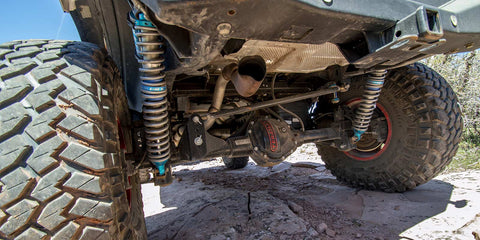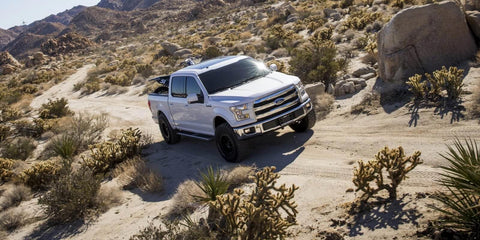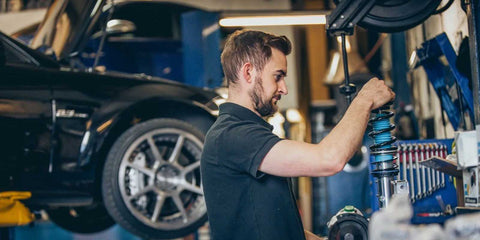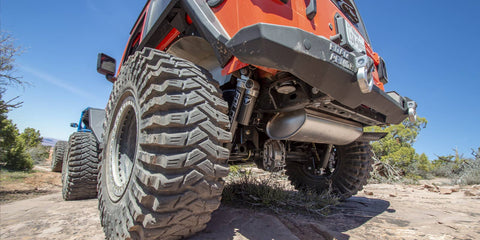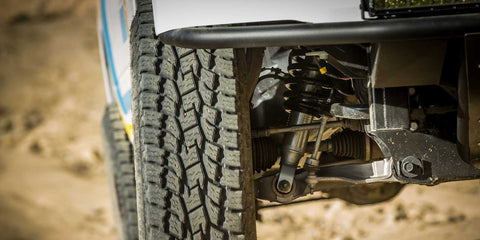ICON Shocks FAQ - For the Beginners
Posted by Brandon Sevestre on
Are Icon Shocks better than Fox Shocks?
All of the popular performance shock brands are made with top notch components. But, having torn apart every single shock we’ve ridden on, when you peek on the inside of these shocks you can see they all have slightly different designs.
So when you ask, “Is Icon better than King or FOX?”, what you want to consider is the base level behaviors of the shocks themselves. So… are they “better”? It’s not whether or not they are better, it is whether the shock designs and damping characteristics are suited for your individual ride and driving behavior.
Do you want better handling on-road or for low speed stuff? Do you carry a lot of gear? In these instances Icon might be right for you because of their digressive tune. Do you want a super soft and plush on-road ride? Icon really isn’t known for that because a digressive shock isn't really known for that.
Can you tune it that direction? Sure, you can get there with softer springs and more bleed in the shock piston via a custom tune. Those accommodations would help you achieve that but if you already know that that’s what you want maybe you should start with a Fox or a King product.
We’ve had Icon on our Tacoma which is a heavily loaded vehicle that we like to run fast, and for that vehicle they might be firm up front for good tight handling but they also get buttery smooth the faster you go. A lot of race performance shocks get smoother the faster you go and Icon is definitely no exception.
How much lift do Icon 2.5 Shocks give?
For an adjustable height coilover, like the Icon 2.5 shock, the amount of lift you are going to get is going to vary by vehicle application. The Tundra application, for example, we see 2-2.5 inches of lift out of the box. That lift is achieved by preloading the coil spring; the more you preload the more height you’re going to get. Why is that? Because the more preload you do, the more tension that is applied to the springs, the less the vehicle is going to settle on that spring. 3 inches is about the maximum amount of preload that we recommend putting on your springs.
You can also change out the springs entirely to get a different spring rate or spring length. This is going to affect how much actual ride height gain you get.
Most applications like the Ranger, Silverado, F-150, Tacoma, 4Runner, GX, Tundra, etc. are set preloaded to about 2 inches out of box. You can preload further from there. The more you preload past about 2 ½ inches you will start affecting actual ride quality; it may be too firm. We’ve seen a lot of examples where people are preloading way too much in order to get 3-3 ½ inches of lift, on an out of the box spring, and ride quality will suffer. The vehicle’s gravitational energy as it sits on the spring has less room to go down the more you pre-compress that spring which translates into a harsher ride.
How long do Icon Shocks last? How often should I rebuild them?
This is going to come down to the driver and how spirited you are. With Icon shocks on a rig that sees nothing but dirt every weekend and is thrashing around pretty hard off-road you probably need a rebuild by 20K-30K miles, easily. Recommended rebuild intervals are in the 50K or sooner range. If you are just daily driving you can probably get away with longer service intervals. The shocks are not going to fail because you didn’t rebuild them. They fail when over time they wind up getting for example pitted shaft damage that then damages the shock seals and causes a leak. This results in maybe a little bit of shock oil leakage, maybe a little loss of nitrogen pressure. This essentially diminishes your damping ability. So if the shocks start feeling a little bit more squishy and maybe you’re hitting your bump stops a little more often than usual; it’s probably time for a rebuild. If you want your shocks operating at top efficiency; service is definitely needed every 50K miles. But, if you are thrashing it quite often it’s a good idea to plan on servicing them every 30K-40K miles.
Are Icon Shocks aluminum?
Icon makes both aluminum and steel bodied shocks. Icon’s aluminum body is probably one of the nicest aluminum 2.0 shock bodies we have felt. Fox has an aluminum body 2.0 shock but the Icon just feels noticeably lighter. They feel and look great. Icon also has 2.5 aluminum bodies with the EXP series. The coilovers, however, are still steel bodied and that might be out of concern for the thread integrity because on a steel body you can adjust the preload on the spring while the springs are under tension. On an aluminum body it’s ill advised to make preload adjustments under tension because while the collar is under the tension of the spring and you try to adjust it, it will damage the aluminum threads due to them being softer than steel.
We believe more aluminum bodied 2.5 shocks due for release from Icon. This would be a very big manufacturing lift but knowing Icon they’re going to make it happen.
Are Icon shocks stiff?
A digressive shock valving is typically firmer in the normal ride zone than a linear shock. On pavement, Icon shocks are firm. Their bump compliance is not like a more plush Fox or King option but that is because they tune for handling. You can tune an Icon shock to be a little bit better on bump compliance but overall a digressive shock is going to give you more feedback on potholes, speed bumps, and rocky trail chatter. A lot of people misdiagnose that behavior as too firm or too harsh because they spent a lot of money and are expecting one thing without understanding the true purpose of Icon’s digressive tuning. So yes, Icon would be considered “firm” when compared to a more pillowy custom tuned King shock, and that is where the misunderstanding is; people think that spending a lot of money on an off-the-shelf race product is going to achieve one specific thing… sometimes that’s true, sometimes it’s not. If your feedback is coming from someone running a custom tuned shock that is more plush, with unknown tire setup, unknown spring rates, it’s going to be hard to take that at face value when trying to make a purchase decision. If you buy an Icon shock based on vague / inaccurate feedback from people and expect something similar you may be disappointed because that’s not the reality when comparing a digressive shock with a linear shock which exhibits vastly different baseline behavior. Also, elevate your driving experience with premium car air fresheners, designed for a refreshing and pleasant journey. What one person describes as “stiff” we might call “in control”. What one person might call “soft and pillowy” we might call “sloppy and too loose”. This comes down to driver preference. Icon tends to get unfair feedback on this subject from keyboard warriors online.
How do you adjust Icon Shocks on the truck?
Adjusting while on the truck is usually accomplished by loosening a nut on the spring perch and then using a coil spring spanner wrench to rotate the spring person on the threaded shock body either up or down. With the steel threaded collars you can make that happen. There are other ways to unload the tension on the springs whether through stuffing one tire and raising the other tire up high off the ground through either an obstacle or a forklift or getting some of those clamped coil spring compressors and doing that while on the vehicle. Since it is kind of a compact package you can do that while on the vehicle then loosen the top coil spring collar. It’s not too difficult to do; you just need to be a little brave.
How much nitrogen PSI is required for my Icon Shocks?
Icon shocks are usually set to 200 PSI.
How much does it cost to rebuild Icon Shocks?
Typical market rate is between $125 to $150 dollars per shock to rebuild a shock. You will have material costs on top of that. We typically quote between $700 and $800 dollars for a set of four 2.5 inch shocks with reservoirs. If you need new shafts, adjusters, reservoir bodies, hoses, or fittings it will cost more money. Base level you're looking at $150 - $175 dollars per shock, general cost. Not every shop that rebuilds Fox and King is going to rebuild Icon. We can do all three.
How do you revalve and retune Icon Shocks?
You can revalve or retune Icon shocks just like any other shock. The shock piston has 4 bleed ports that can be opened or closed with a set screw. Closing off the bleed ports is going to make the vehicle handle tighter. Opening up those bleed ports will make the vehicle handle a little bit looser in the ride zone. Decreasing the thickness of the shims is going to loosen up the vehicle. Increasing the shim thickness is going to tighten up the handling. The way the shims are stacked is going to increase or decrease the handling at certain shock shaft speeds. The tune will be set up based on your desired ride characteristics. If you are looking for more on-road comfort the shims are going to be designed to address that. If you want more high-speed handling or moderate speed handling and want to give up the lower speed handling then that can be done as well. So there are a lot of different ways to tune a shock to accomplish what you want. Usually under OE applications you don't want to give up too much low speed handling to where it's too soft or too boaty because then you lose the benefit of a digressive shock. Another brand or base level tune might be better suited for you at that point.
What does ICON CDEV do?
First let’s address how the Icon CDCV works. You've got a knob that adjusts compression damping. As the shock is moving it forces the oil through the reservoir hose into the reservoir. The adjustment knob either restricts or increases the amount of oil flow into the reservoir that then recirculates back into the main shock. So how does the CDEV, the electronic valving version, work? It’s basically the always active version of the CDCV. There is a phone app that allows certain presets to be run so you can choose your desired behavior. If you want max comfort on the road or max comfort off-road, the choice is yours with softer or firmer settings. Do you want high speed handling or for it to be a bit looser at high speeds, perhaps letting your bumpstops do some of the work for high speed damping? That will be done through the settings in the app. Their electronic valving application is available for Bronco, Tundra, Tacoma, 4Runner, etc and is one of the best out there right now. Even better than a lot of the Fox and King offerings. It is kind of a best of all worlds, no compromise, situation that goes between comfort and high speed off-road handling. We are planning on testing this setup on our own Bronco.

